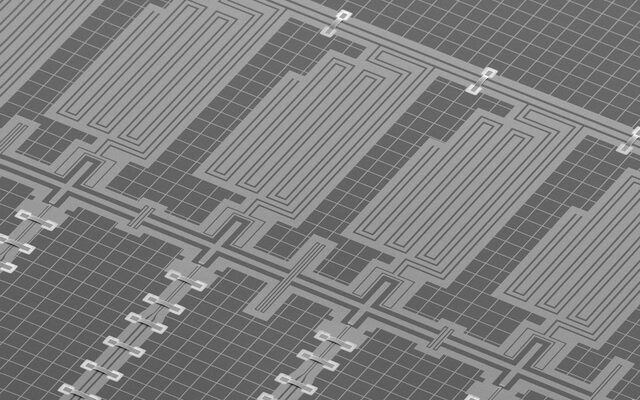
Hub for Imaging and Quantum Technologies
The Hub for Imaging and Quantum Technologies cluster will establish Johns Hopkins University as a worldwide leader in the area of quantum science and its revolutionary application to technology and fundamental physics. This cluster will recruit scholars who will lead efforts to push beyond the current limits of imaging and quantum technologies by developing cutting-edge tools for a wide range of research areas.
Measurement science is experiencing a revolution driven by breakthroughs in imaging technologies and quantum enabled technologies that are expected to far exceed what is possible with traditional tools. The cluster, supported by state-of-the-art infrastructure, will put Hopkins at the forefront of this transformation.
Our investment
This cluster’s investment in research includes: 4 Bloomberg Distinguished Professorships and 4 junior faculty positions. These faculty, along with the cluster leads, will collaborate together along with existing Johns Hopkins faculty on this important area of research.
The cluster will be a center for tool development, bringing together diverse expertise in metrology and sensing and opening new frontiers in fields as far ranging as particle physics, cosmology, quantum material science, chemical reactivity, biological processes, medical diagnostics, classical and quantum computing, geophysics, navigation, and national security.
Interested in this cluster? Contact us to learn more.
The cluster will hire a diverse, interdisciplinary team of scholars to address the challenge of defining and developing the next state-of-the-art imaging and quantum technologies and provide visionary leadership for the application of these technologies to all aspects of society. Cluster scholars with different research pursuits will be united through the common goal of innovative imaging and quantum technologies.
The cluster also will work to:
- Strengthen Johns Hopkins University’s material science effort fundamentally and in applications to quantum sensing, computing, and other devices
- Grow an atomic, molecular, and optical systems (AMO) group at Hopkins to address questions in fundamental physics while also connecting with device generation
- Create deeper connections among the Applied Physics Lab, Krieger School of Arts and Sciences, and the Whiting School of Engineering to take full advantage of the expertise across the institution
Cluster scholar backgrounds may include:
- Quantum devices from materials: contribute world-leading expertise in device fabrication and in concrete theoretical design of technologies based on quantum parts; bringing together quantum materials and quantum sensing under a single umbrella provides the unique opportunity for the synergistic development of materials engineered at the atomic scale for specialized responses for sensors and computations
- Quantum sensors to understand the planet and the universe: contribute expertise in AMO which is driving the revolution in fundamental experimental research
- Quantum information: Develop aspects of quantum encryption and computation; having an expert who bridges to quantum information ensures that development of QUEST have broad impact
- Biological applications of quantum materials and sensors: an individual with expertise in making the bridge to medicine and health, for quantum sensing to revolutionize medical imaging and health tracking.
- Meta-lenses and flat optics: mastering the manipulation of light and heat at the nanoscale by harnessing recent advances in exciton-polariton physics. Breakthroughs in meta-surface and meta-lens research are of particular interest.
- Quantum metrology: development of quantum sensors capable of extremely sensitive and igh fidelity signal detection in the presence of noisy native backgrounds.
- In situ Cryo-Electron Tomography (cryo-ET)
- Correlated microscopy: a crucial element of the cluster’s goal of linking often disparate spatial and temporal scales at which phenomena occur in complex systems. Streamlining the process of correlating and “stitching together” data from different techniques will be a crucial thrust.
- Data science as applied to imaging tools: massive and hyperspectral data sets will need to be stored, curated, and made available for efficient retrieval. Data science will also assist in realizing closed-loop processing of new materials and will enable the massively parallel imaging solutions envisioned above
The cluster will build on specific expertise and institutional advantages that position Johns Hopkins to become a center for innovation in imaging and quantum technology. Existing faculty, institutes, and centers at Johns Hopkins have laid a firm foundation for leadership in these areas, and a cluster of scholars dedicated to realizing the next-generation of imaging and quantum technologies will position the university at the frontier of the imaging and quantum transformation of science, technology, and society.
Scientists and technical staff at the Applied Physics Laboratory are pushing the boundaries of materials-based sciences, with demonstrated leadership in developing new quantum materials and quantum sensing technologies that pave the way for smaller, lighter, tougher, safer, more efficient and durable technological systems. Impactful research in quantum atomic, molecular, and optical systems and in quantum material science requires core scientific expertise as well as on-going connections and collaboration with the application of such research. Recruiting scholars with collaboration opportunities across schools will bring significant and inherent value to Hopkins and to the enterprise as a whole.
Existing faculty strengths in nearfield and atomic force microscopy, ultrafast spectroscopy, fluorescence microscopy, single-molecule imaging, cryo-EM, mass spectroscopy and surface patterning, and confocal methods with electrostatic feedback control provide a leading ecosystem that would have multiple synergies within the cluster.
Johns Hopkins University has significant resources and infrastructure in place to support the scientific goals of this cluster, including the personnel and laboratory resources of the Institute for Quantum Matter and the Platform for the Accelerated Realization, Analysis, and Discovery of Interface Materials Bulk Crystal Growth Facility, APL’s Research and Exploratory Development Department (REDD)’s new facility, and the Physics & Astronomy Department’s Instrument Development Group with a world-class fabrication facility. Johns Hopkins is also currently home to several centers of excellence in the area of biological and materials metrology: The Beckman Center for Cryo-EM, the Platform for the Accelerated Realization, Analysis, and Discovery of Interface Materials, and the Materials Characterization and Processing facility.